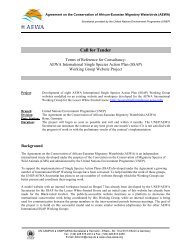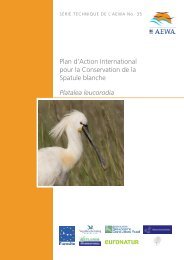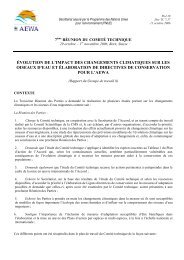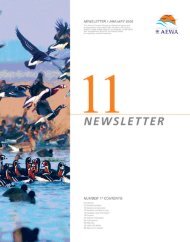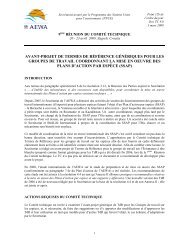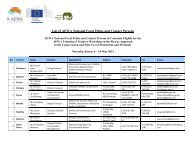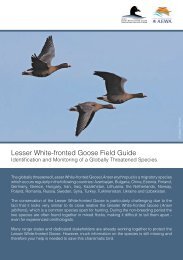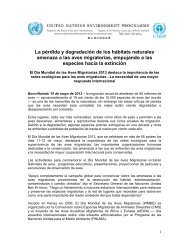Black-winged Pratincole - AEWA
Black-winged Pratincole - AEWA
Black-winged Pratincole - AEWA
Create successful ePaper yourself
Turn your PDF publications into a flip-book with our unique Google optimized e-Paper software.
<strong>AEWA</strong> Technical Series No. 4<br />
2. Biological Assessment<br />
General<br />
information<br />
The <strong>Black</strong>-<strong>winged</strong> <strong>Pratincole</strong> Glareola nordmanni is a small Palearctic wader, one of the<br />
representatives of the specific Glareolidae wader family. It breeds in the steppe and desert<br />
belt of Eurasia, and winters in tropical Africa region. The <strong>Black</strong>-<strong>winged</strong> <strong>Pratincole</strong> prefers<br />
to breed on dry salted soils (“solonets” and “solontchak”) with low vegetation cover and<br />
patches of bare ground, and on overgrazed steppe pastures. It avoids steppes with high<br />
vegetation. Sometimes inhabits arable land (ploughed fields). Often feeds in the air,<br />
catching flying insects.<br />
Population<br />
development<br />
• Population decline, which has been observed since the end of the 19 th century,<br />
probably is caused by the extensive ploughing of virgin steppes for development of<br />
arable agriculture.<br />
• Extremely rapid decline was recorded in the middle of the 20 th century; it was more<br />
dramatic in the western and northern parts of the species breeding range.<br />
• In the second half of the 20 th century numbers of the <strong>Black</strong>-<strong>winged</strong> <strong>Pratincole</strong> became<br />
locally stable or even increased, which was presumably related to the irrigation of<br />
steppes.<br />
• In the 1990s population again started to decline sharply; this is most marked in the<br />
south of Russia.<br />
Distribution<br />
throughout<br />
the annual cycle<br />
• Breeding range of the species stretches throughout the steppe zone of Eurasia from<br />
Romania and Ukraine in the west to the Russian Altai and Kazakhstan in the east.<br />
Irregularly the species is recorded during breeding further north, in the forest-steppe<br />
zone. In the north of the desert zone locally it forms large colonies in the valleys and in<br />
the river deltas.<br />
• Winters in savannahs of southern and south-western Africa.<br />
• Transit migrations through countries in the Middle East and the Arabic Peninsula are<br />
almost inconspicuous; however migration is observed in Africa close to the equator.<br />
Productivity<br />
Very low. From 60% to 100% of clutches and chicks die annually because of:<br />
• Trampling of nests and chicks by grazing cattle.<br />
• Increased predator pressure, namely by corvids.<br />
• Predation by terrestrial mammals, which varies from year to year depending on<br />
availability of other food sources.<br />
• Heavy rains and hailstorms.<br />
• Severe droughts.<br />
16 International Single Species Action Plan for the Conservation of the <strong>Black</strong>-<strong>winged</strong> <strong>Pratincole</strong>




